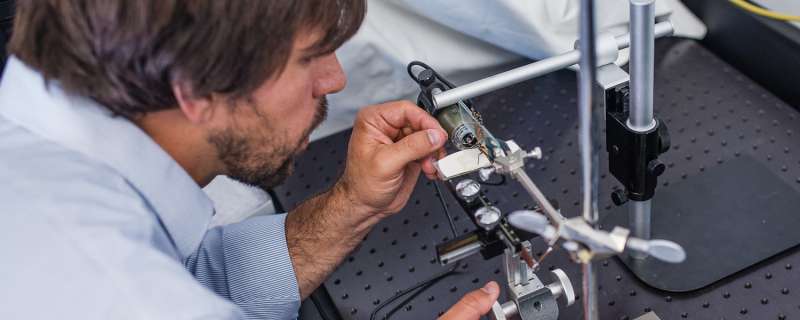Unraveling mysteries of mouthparts of butterflies

Imagine that the way flies and butterflies drink nectar and other fluids can be imitated for use in medicine, potentially to deliver life-saving drugs to the body—and also how this method can save their own lives in times of drought.
This is the kind of critical research being done every day by faculty and students at Kent State University at Stark.
A study by Matthew Lehnert, Ph.D., assistant professor of biological sciences at Kent State Stark, shows that the method in which flies and butterflies ingest liquids into their own bodies for nourishment may be used as a model for delivering disease-fighting drugs to the human body. Drug delivery systems are engineered technologies for the targeted delivery and/or controlled release of therapeutic agents. They control the rate at which a drug is released and the location in the body where it is released.
In addition to enhanced drug delivery methods, by copying their feeding systems, scientists and engineers could manufacture small probes that can sample fluid inside of cells for use by doctors or other clinicians to make diagnoses.
Butterflies and flies have mouthparts that have a channel for fluids to travel from the liquid source to the head for ingestion, Lehnert said. This study also found that there is a limiting pore size from which each individual can feed—butterflies and flies with smaller mouthpart channels will be able to feed on liquids from smaller pores, which might have an advantage for the insects and more broadly for the ecosystem in case of a drought.
Lehnert, three of his Kent State Stark undergraduate student assistants and four other researchers found that flies, butterflies and moths (20 percent of all animals) use capillary action, or the movement of liquids seamlessly from one place to another, as the guiding principle when feeding on liquid films—their primary source of food. An insect's proboscis, a body part that allows them to drink liquids, acts like a highly-sophisticated sponge and straw that uses capillary action to send nectar or other liquids to the insect's diges tive system.
Their findings were published recently in Proceedings of the Royal Society B: Biological Sciences, one of the world's top science journals.
In order to feed on nectar and other liquid films, natural selection has favored the evolution of specialized mouthparts in fluid-feeding insects. In butterflies and flies, the mouthparts consist of a proboscis adapted for using capillary action to pull thin films of fluid from surfaces for subsequent feeding. Usually, the proboscis of flies and butterflies is held close to the underside of the head when not in use and when the insect is searching for food.
The team's findings show that capillary action is an essential and ideal method for removing small amounts of fluids from surfaces, Lehnert said. By copying this natural method, scientists say the mouthparts of flies and butterflies can serve as models for developing new devices for improved drug delivery systems.
"It was previously known that flies and butterflies independently evolved mouthparts adapted for feeding on fluids, but what was unknown before our study was that they both use the same principles for ingesting fluids - capillary action," Lehnert said. "Our findings have applications to the production of novel microfluidic devices that can be developed to mimic the functionality of insect mouthparts, which have the advantage of being impacted by natural selection over millions of years."
More information: Matthew S. Lehnert et al. Mouthpart conduit sizes of fluid-feeding insects determine the ability to feed from pores, Proceedings of the Royal Society B: Biological Sciences (2017). DOI: 10.1098/rspb.2016.2026
Journal information: Proceedings of the Royal Society B
Provided by Kent State University




















